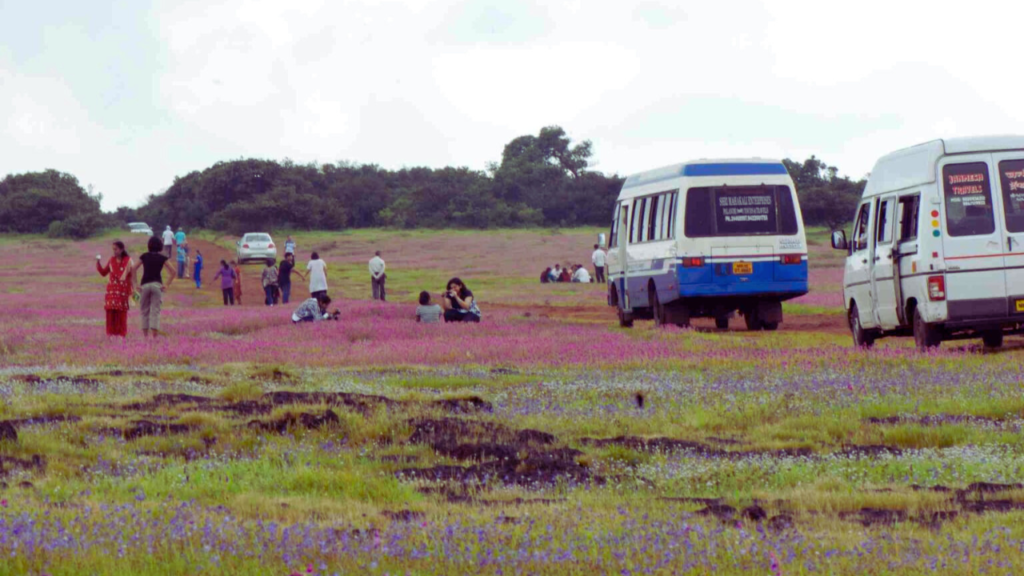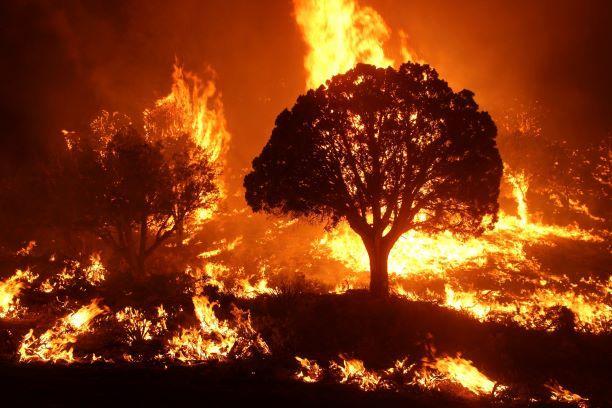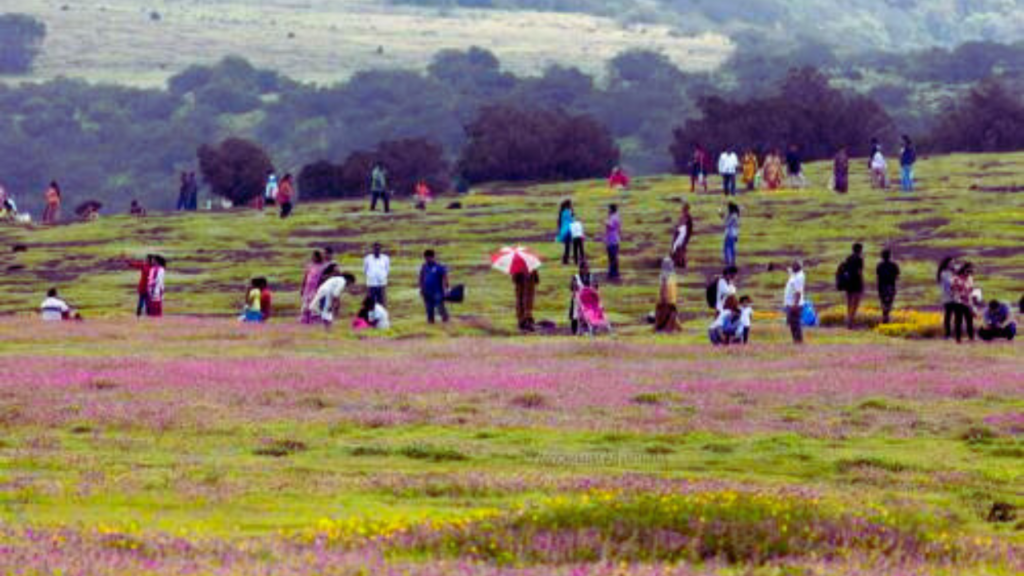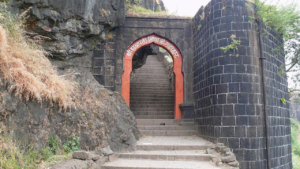Introduction:
When you visit the Kaas Plateau in the Western Ghats of Maharashtra, India you’re witnessing a true gem of natural beauty and ecological significance. The Kaas Plateau Ecosystem is considered a biodiversity hotspot and has been declared a UNESCO World Natural Heritage Site. Coming from this background, we’ll take a closer look at the mesmerizing features of the Kaas Plateau and its significance in the realm of conservation.
Looking at out over the landscape, the Kaas Plateau’s altitude of 1200 meters above sea level is inescapable, and its ten square kilometre expanse is a veritable rainbow of colour. With in excess of 850 flowering plant species. Some of which are endemic and endangered, the plateau is a floral haven. During the monsoon season, from August to October, the plateau is transformed into a stunning spectacle of vibrant blooms, attracting people from far and wide, and the region’s floristic appeal.

The Western Ghats as a whole, is widely regarded as one of the eight biodiversity hotspots in the world, and Kaas Plateau is the undisputed crown jewel in this landscape because of its very high variety of plants and animals.
In 2012 the Kaas Plateau was granted a UNESCO World Heritage Site, a status that recognises the world-wide significance of its rare natural beauty in the areas of biodiversity conservation and sustainable development.
Assessing the fragile Kaas Plateau ecosystem, the impacts of local pressure and over time have been particularly harsh. Overgrazing and burning, for example, have stressed the plateau, and the coexistence with domestic cattle, wild mammals and the rare indigenous species, results in competition for resources.
The construction of a road through the plateau brought about several unfortunate incidents of road kills, specifically on snakes and, in 2015, two leopards perished in a car crash. The addition of manure by farmers was only marginally justified. One issue was the unfortunate result of eutrophication, when the accumulation had to be controlled.
Trampling, caused by cattle and people, have made numerous paths on the plateau, and it is difficult to know what has happened to the plateau’s diversity, as we lacked a point of reference, since the beginning.
Threats to the Kaas Plateau Ecosystem

.Looking at the Kaas Plateau ecosystem, it’s clear that it’s been suffering from a lot of local pressures. Historically, the overgrazing and burning have been hard on the plateau, and domestic cattle sharing the space with the wild animals puts a strain on the available resources. Coming hustling over through the plateau on a road hasn’t helped either, with all too often resulting in the deaths of snakes. The use of manure has also started the process of eutrophication, which is not good news for the plateau.
Trampling by cattle and humans has created lots of paths on the plateau and basically turned it into a mosaic of trampled areas, but because we don’t have enough baseline data, it’s difficult to know what the original state was.

Looking at the plateau in recent years, one of the major concerns that have arisen is the impact of tourism. Since 2012, the sudden growth in the number of visitors has led to alarming rates of vegetation trampling, damage to microhabitats and problems in solid waste management.

Unseen effects include the transformation of land use patterns in the area, and social, economic and cultural shifts in the nearby villages.
Well-known to be essential to combatting this threat, a complete understanding of the ecological, socio-economic and cultural implications of the tourism growth will be vital to any effective conservation strategies we create.
Habitat Destruction and Fragmentation
Looking at the pressing issues facing the Kaas Plateau’s ecosystems, habitat destruction and fragmentation stand out as major threats to the area’s biodiversity. The driving forces of deforestation, forest fires and urbanisation have a devastating effect on habitats.
Deforestation, or the clearance of forests, takes place for a number of purposes, but most often for the construction of infrastructure. Coming heading into the picture, it has the double whammy of sending the area’s biodiversity plummeting and pumping massive amounts of carbon dioxide into the atmosphere.
Habitat loss and fragmentation send the populations of the species that live in the area into a spin. Species that used to have vast, unbroken habitats are now confined to smaller forest areas and run up against issues like food and water shortages, increased competition and reduced genetic diversity.
Conservation measures must be put in place to stop the destruction and fragmentation, and protect the remaining habitats. Protecting designated areas, replanting efforts and sustainable land management that takes into account the needs of wildlife can all contribute to the preservation of existing ecosystems.
The whole balance of local ecosystems can be severely impacted, and the main reason is that these plants can be found only in very specific regions or environments, when endemic plants are lost. If they disappear, it’s very hard to get the same species back. The decline in endemic plants also throws off the natural processes like nutrient cycling and soil stabilisation.
Coming racing on the heels of this issue, is the alarming decline in pollinators and other wildlife. Pollinators are basically the unsung heroes of the plant world, helping them reproduce by transferring pollen between flowers, which in turn produces the fruits and seeds that we all know and love, but factors like habitat destruction, climate change, and invasive species have seen pollinator numbers plummet all over the place. This makes it impossible for many plants to reproduce.
Well-known measures to tackle these problems are recognising the value of preserving our flora and fauna, protecting endangered species, restoring habitats, and reducing pollution levels. One of the measures the Maharashtra government has taken was removing the protection fence on the Kaas plateau since 2022.
Urbanisation and Infrastructure Development
The landscape is often redefined, when urbanisation and infrastructure development take hold in a region. Cities continue to expand, and construction projects and road developments become the norm in shaping the urban landscape. However, the price of such growth and the need of construction and new roads are well-documented: they have resulted in habitat destruction and hurt a lot of the local wildlife.
Kaas Plateau, a UNESCO World Heritage Site, is facing the same threats, illegal construction and the like.
Well-known is the displacement of indigenous plant and animal species when natural spaces are cleared out for construction. This can lead to significant decline in populations and even extinction for species that cannot adjust to the changes.
Coming from the destruction of natural areas, ecological balance is severely disarranged.
Original plants, those that feed and shelter wildlife, get knocked out and are replaced by non-native species, which can ultimately lead to the collapse of the ecosystem.
It’s crucial to give equal weight to both the need for urban infrastructure and the preservation of the natural environment, when planning for the future of cities. In urban planning, green spaces can be created, wildlife corridors built to bridge isolated habitats, and sustainable construction practices put into place. When this holistic approach is applied, biodiversity in urban areas is recognized, and it is necessary to bring about a beautiful harmony between man-made and Mother Nature.
By squaring the needs of urban growth with the conservation of the environment we can craft cities that provide for human happiness and supercharge ecosystems such as the Kaas Plateau.
Tourism Pressure Affects the Kaas Plateau Ecosystem:
Unregulated Visitation & Lack of Awareness
You’re in for a treat, but the plateau’s beautiful and unique ecosystem is facing a very real threat from mass tourism and a general lack of awareness of the importance of conservation, when visiting the breathtaking Kaas Plateau.
The plateau’s peak seasons see a huge influx of tourists who, due to the lack of proper management and education, have been disturbing and trampling the delicate vegetation, dislodging topsoil, and knocking over habitats that should be protected. The litter and improper waste disposal left behind further damage, that no repair can fix.
A major element that has caused and is still causing the mess up on the Kaas Plateau is the fact that many of the tourists visiting the plateau are unaware that the area is home to something so rare.
It’s fundamental to get a grip on visitor numbers, especially during peak periods and make sure that people understand the need to conserve the area’s ecosystems, when tackling the problems faced by Kaas Plateau.
Implementing visitor quotas, having trained naturalist-led tours and pushing forward sustainable tourism initiatives are some of the ways we can effectively manage the impact of tourism on the plateau.
By raising people’s awareness about the sensitivity of the Kaas Plateau’s ecosystems and encouraging them to behave responsibly, we can make sure that this natural wonder will be available for our children to enjoy in the future, and won’t be overburdened by the growing number of tourists.
Visitors are asked to visit the official website of the Kas Plateau Forest Management Committee and read the guidelines for the conservation of Kas Plateau.
Conclusion:
The Urgent Need for Conservation Efforts to Protect the Kaas Plateau Ecosystem.
Website link: Exploring the Beauty of Kas Pathar: A Guide to Booking Your Trip in 2025
What are the threats to the Kaas Plateau?
Kaas Plateau, a UNESCO World Heritage Site, may be under threat due to Illegal Construction, construction projects, and roads.
What is the biodiversity of the Kaas Plateau?
This unique Kaas Plateau Ecosystem has gained recognition as a biodiversity hotspot and has been designated as a UNESCO World Natural Heritage Site.
What are the environmental issues in the Kaas Plateau?
Habitat destruction and fragmentation are two critical environmental issues that have a significant impact on biodiversity and Kaas Plateau ecosystems.
What is the importance of the Kaas plateau?
It is home to more than 850 species of flowering plants, including several endemic and endangered species.
How was the Kaas Plateau formed?
Kaas Plateau was formed by volcanic activities and is covered by a thin soil cover, as a result of which, no vegetation thrives in the region. This area comes under a very high rainfall zone. Due to this, the flora and fauna of the region are unique and endemic




